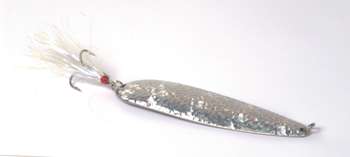
The Nichols Bait Co. Lake Fork Flutter Spoon was introduced to give anglers an easy way to bag a trophy bass anywhere in the country. Part 1 of this three-part series discussed the spoon’s origins, detailed the best gear to use when lobbing a giant spoon and touched on how important a good understanding of your sonar unit is to proficient spoon fishing.
In this installment we detail where Lake Fork guide and spoon aficionado Rick Loomis targets suspended fish throughout the year using his sonar unit.
Loomis and his clients will throw the Lake Fork Flutter Spoon three seasons out of the year, the exception being the super-cold waters of winter. He starts throwing it to postspawn fish and will quit using it as the females begin to fill up with eggs for the spawn.
“The prime time for these spoons is now (mid-October) through December,” Loomis says. “Now they’re feeding up on shad and not worried about crawfish, so the spoon is the perfect bait. This thing looks just like some of the gizzards they spit up.”
Since the spoon is an open-water bait, structure is key — and central to finding good structure is knowing what to look for on your sonar unit. Loomis starts his yearly routine in late April and into May around points and humps adjacent to spawning flats. He has his best luck in water about 24 feet deep. He fishes water near these points and humps year-round, varying the depth of water he attacks as the seasons change.
“April or May through late June, they’ll be close to the bottom, maybe 2 or 3 feet off,” he says. “When you find them, toss a buoy — not on top of them or you’ll spook them — and back off and start casting around it.”
As late June approaches, the warming water moves the bait, which moves the bass. Loomis finds most of his fish in the same areas, but in slightly deeper water. The exception is fish hunkered in a brushpile on the bottom.
“They’re following bait as they migrate deeper,” he says. “They’re in smaller groups now, maybe eight or ten, when there may have been 30 or 40 clumped together earlier, but you can catch just as many fish now.”
Loomis reasons that if you have six or seven spots you can rotate through over the course of a day, the spots will reload as you fish different areas. As September approaches, Loomis begins to look shallow early in the day, then deeper as the days cool.
“I may catch ’em in 18 feet early on, but as the water cools and the days get shorter, they search out the warmer water, which is deeper,” he says. “You can take a temperature probe and it may be 8 degrees warmer in 40 feet than it is in 20. They’re following the bait again.”
While it may sound like Loomis is driving all over the lake, he is in fact staying in the proximity of where he found the postspawn fish. As the bass make their yearly migrations, he uses his graph and buoys to keep tabs on them so he keeps his boat near the action and his clients happy.
“When they start to get full of eggs, they begin to migrate back to where they spawn, and it starts all over again come May,” he says.
The final installment on these megaspoons reveals Loomis’ plan of attack for each season.




